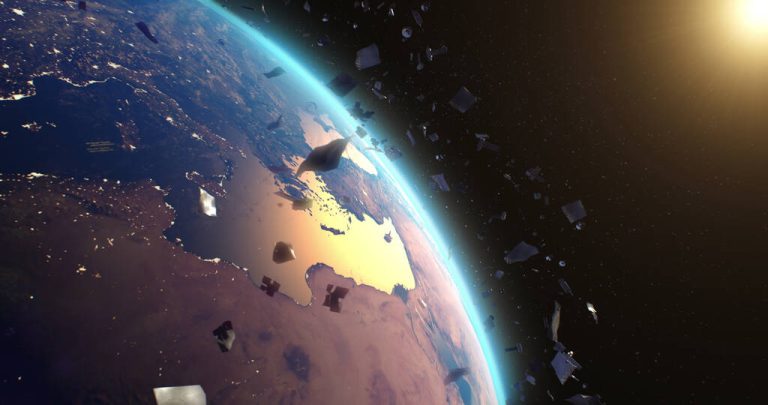The Risk of Artificial Satellites Falling to Earth: What You Need to Know
Artificial satellites and space debris pose significant risks both in orbit and upon re-entry into Earth’s atmosphere. The increasing amount of space junk threatens satellites, astronauts, and even people on the ground. Understanding the current state of space debris, its potential impacts, and preventive measures is crucial for maintaining the safety and sustainability of space operations.
Summary
- What is Space Junk?: Human-made debris orbiting Earth, including defunct satellites and broken spacecraft.
- Current Space Junk Statistics: Over 29,000 tracked pieces, with trillions of smaller, untracked fragments.
- Problems Caused by Space Junk: Potential damage to operational spacecraft, satellites, and risk of debris falling to Earth.
- Space Junk Falling to Earth: 200 to 400 pieces annually, mostly burning up but occasionally causing incidents.
- Notable Space Junk Incidents: High-profile crashes and collisions involving space debris and satellites.
- Environmental Impact: Possible atmospheric pollution and ozone layer depletion from burning debris.
What is Space Junk?
Space junk, also known as space debris, refers to any man-made object left in orbit around Earth that no longer serves a useful purpose. This debris can include:
- Defunct Satellites: Satellites that have completed their missions but remain in orbit.
- Broken Spacecraft: Pieces of spacecraft that have collided or broken apart.
- Rocket Parts: Components of rockets that were used to launch objects into space.
- Tiny Paint Flecks: Minute pieces of paint or other materials that have been chipped off from spacecraft.
Types of Space Debris
- Large Debris: Includes defunct satellites, spent rocket stages, and fragments from major collisions.
- Medium Debris: Pieces from the breakup of larger objects or collisions.
- Small Debris: Paint flakes, bolts, and other tiny fragments that are too small to track but still pose a threat.

How Much Space Junk is There Right Now?
Currently, scientists track over 29,000 pieces of space debris larger than a softball, according to the European Space Agency (ESA). This includes about 3,000 defunct satellites that are left in orbit, as reported by the Natural History Museum of London.
However, the majority of space junk is too small to be tracked. Estimates suggest there are over 100 trillion untracked fragments, mostly less than 0.4 inches (1 cm) wide. Even these tiny pieces can cause significant damage due to the high velocities involved.
Table 1: Space Debris Statistics
| Type of Debris | Tracked Pieces | Untracked Pieces |
|---|---|---|
| Large Debris | 29,000 | N/A |
| Medium Debris | N/A | N/A |
| Small Debris | N/A | 100 trillion |
Why is Space Junk a Problem?
Space junk presents several problems:
- Collision Risk: Objects in orbit travel at speeds exceeding 15,600 mph (25,200 km/h). Even small debris can cause catastrophic damage if it collides with operational spacecraft.
- Historical Incidents: In 2016, a small paint fleck hit a window on the International Space Station (ISS), leaving a quarter-inch dent. The high-speed impact highlighted the risk posed by even tiny fragments.
- Chain Reactions: Collisions between debris can create even more fragments, leading to a chain reaction known as the Kessler Syndrome, which exacerbates the problem.
Can Space Junk Fall to Earth?
Yes, space junk does fall to Earth. On average, 200 to 400 pieces of tracked space debris re-enter the Earth’s atmosphere each year. Most of these are small enough to burn up completely before reaching the ground. However, larger objects can sometimes survive re-entry and land on Earth.
Notable Space Junk Incidents
- August 2022: A chunk of a SpaceX Crew Dragon spacecraft landed on a sheep farm in Australia.
- March 8, 2024: A piece of space debris crashed into a Florida family’s home. NASA confirmed it was part of a cargo pallet from the ISS.
- May 2024: Large chunks of SpaceX Dragon capsules crash-landed in North Carolina and Saskatchewan.
Table 2: Recent Space Junk Incidents
| Date | Incident | Location | Details |
|---|---|---|---|
| August 2022 | SpaceX Crew Dragon chunk | Australia | Landed on a sheep farm |
| March 8, 2024 | Space debris crash | Florida, USA | Damaged a home; part of ISS cargo pallet |
| May 2024 | SpaceX Dragon capsule chunk | North Carolina, Canada | Crash-landed on properties |
Space Junk Incidents in Orbit
Space junk incidents also occur in orbit:
- February 10, 2009: A defunct Russian spacecraft collided with a U.S. Iridium satellite, creating over 2,300 pieces of debris.
- March 2021: A Russian rocket fragment destroyed a Chinese military satellite.
- June 2021: A small piece of space debris damaged the ISS’s robotic arm.
These incidents underscore the growing problem of space debris and the need for improved management and mitigation strategies.
Environmental Impact
Recent studies suggest that deorbiting space debris may contribute to atmospheric pollution and possibly affect the ozone layer. As debris burns up upon re-entry, it can release metal contaminants into the atmosphere. Further research is needed to understand the full environmental impact.
Preventive Measures and Future Directions
Addressing the space junk problem involves several strategies:
- Space Debris Mitigation Guidelines: Implementing practices to minimize debris creation, such as designing spacecraft to deorbit at the end of their mission.
- Active Debris Removal: Developing technologies to capture and remove large pieces of debris from orbit.
- International Cooperation: Establishing global treaties and agreements to manage and reduce space debris effectively.
Conclusion
The increasing amount of space junk poses significant risks to satellites, spacecraft, and people on Earth. Understanding the current state of space debris, its potential impacts, and preventive measures is crucial for maintaining the safety and sustainability of space operations.
Hashtags:
#SpaceJunk, #SpaceDebris, #OrbitalDebris, #NASA, #SpaceSafety, #EnvironmentalImpact, #SpaceCollisions, #SpaceExploration, #Satellites

